
Updated 26 August 2012

|
Updated 26 August 2012 |
|
HOME PAGES GLOBAL WARMING WHAT YOU CAN DO GREEN ISSUES BACKGROUND THE INITIATIVE |
This page offers advice on effective energy saving in the home: free or low-cost savings, what can be achieved by home improvements, and some more detailed discussions on heating, windows, fridges and freezers, appliances, energy labels, and leaving items on standby. The cost savings to expect are on a separate page. Finally, we list the possibilities for domestic green energy generation. Efforts to Tackle the Problem We should try to stop using fossil fuels and emitting large quantities of greenhouse gases as soon as possible. As this is difficult to achieve, various practical targets have been proposed internationally. The UK aims for an 80% reduction in greenhouse gas emissions by 2050. Some of this reduction can be achieved by using energy more efficiently. About 27% of the energy in the UK is used in domestic homes, where considerable energy savings can be made. Some of these also save money, and as energy prices rise they become even more cost-effective. The National Energy Foundation website provides a good overview on this subject. As a more complete solution, a large number of different sources of clean energy are being explored. 
Free or Inexpensive Household Energy Savings The following changes cost nothing or very little, and can generate significant energy savings. Lighting 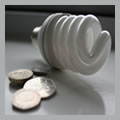
Electric lighting is the largest consumer of electricity in many households. Switch off lights when they are not being used. Use low-energy lights. Replace all incandescent bulbs that are switched on for more than a few minutes at a time with low-energy bulbs (also called CFLs – compact fluorescent lamps), or install light-emitting diodes (LEDs) or conventional fluorescents. Replacing just one 100 watt bulb which is used for 4 hours a day by a 20 watt low-energy lamp would save about 115 kilowatt-hours (‘units’) a year. At 12 pence per unit this would save £13.80, so you save the cost of the bulb within months. Low-energy lamps last much longer than incandescent bulbs, so although they can be more expensive to buy (look for special deals) the cost of purchase over their lifetime is similar or less, and there is also the advantage of not having to replace them. Low-energy bulbs (CFLs) come up to full brightness more quickly than they used to, and there are now some models that work with dimmers or that replace halogen lamps. The range of low-energy bulbs in the shops can be limited, but we have a list of suppliers offering a much wider range. There is much more information about low-energy lighting on our lighting page. Heating 
Reduce the central heating temperature setting by 1 or 2 degrees. Even small changes make very considerable energy savings – a 1°C reduction can save about 10%. Switch heating off or turn the thermostat down when no one is at home; programmable thermostats are now widely available at reasonable prices. Reduce hot water temperature by turning down the thermostat on the tank. If you always have to mix hot water with cold water you are almost certainly overheating the water and wasting energy. Have showers rather than baths as they use less hot water. Insulate (‘lag’) all hot water pipes, particularly the ones between the boiler and the hot water tank. Do not heat rooms that are not being used. Close curtains at dusk. Stop draughts by filling in gaps under skirting boards with paper or mastic. Install draught-proofing strips on windows and doors. Energy-Saving Home Improvements The savings to expect from these measures are discussed separately, on our cost saving page. There are grants available for many of the following items, making them either inexpensive or in some cases free. A list of schemes is available from the non-profit service Cocoon. 
Increase roof insulation. About a third of heat loss can go through the ceiling. Where possible, increasing the thickness of insulation to 270 mm (11 inches) is recommended, and if this is not possible you should certainly have at least 100 mm (4 inches). If you have less than 100 mm, increasing it can give the most rapid return on your investment. Add a jacket to the hot water cylinder if it does not have a foam outer coating. At least 75 mm (3 inches) and preferably more is recommended. This is cheap, easy, and pays for itself within months. Fit cavity-wall insulation. Install a condensing boiler. If your current boiler is over 10 years old, this should reduce fuel usage by perhaps 35%. All new boilers must now be condensing models. There is more information on boilers and heating below. Add automatic heating controls. Room thermostats (especially programmable ones), hot-water cylinder thermostats, timer/programmers, and thermostatic radiator valves are all useful, saving energy while increasing comfort. Fit double glazing or secondary glazing. This halves heat loss through windows, reduces condensation and noise, and is more comfortable. However, for saving energy it is not as cost-effective as the other suggestions. There is more information on windows below. Get a free energy check A simple, free check that suggests what you can do to improve your home and how much it might save is offered by the Energy Saving Trust. Condensing boilers and heating 
Modern boilers are lighter, so less metal has to be heated up when they are turned on; this is more efficient especially in summer when the boiler might be used intermittently to heat water. All new boilers, both gas and oil, must now be condensing boilers, which further increases efficiency by extracting the heat from the steam generated in combustion. The efficiency of these reaches about 91%, compared to perhaps 78% or less for elderly boilers. Condensing boilers collect heat from the flue gases and use it to pre-heat the water returning to the boiler. If the difference between the flow and return temperatures is too low, little benefit is gained from the preheat, so the difference is controlled automatically by adjusting the water flow and heat input. Condensing boilers gain most energy from condensing the steam in the flue gases if the water being drawn into the boiler starts cool. With higher input water temperature, more steam will escape as vapour and less energy will be captured through condensation. Efficiency begins to drop above about 40°C, and falls off rapidly if the input water temperature exceeds 50°C. A generous area of radiators helps to cool the water before it returns to the boiler. A lower output water temperature also results in a lower input temperature, and this can still provide the heat needed if the radiator area is large enough 
Heating water with a gas or oil boiler in summer should be more efficient than using an electric immersion heater, because electricity costs several times more than gas or oil for the same energy. A boiler and the pipework connecting it to the hot water tank would need to be very inefficient for it to be more expensive for water heating than an immersion heater. Combi boilers (left) are a good option for smaller properties. They drive the central heating system and also supply hot water directly, avoiding the need for a hot water tank and the associated heat losses. As the water is heated only when it is required, the flow available is more limited than from a hot water tank. Underfloor heating allows condensing boilers to run at high efficiency, as it provides both the desirable features of a low temperature heat output and a large radiating area. It can be combined with conventional radiators and hot water heating by using a separate control device that can ensure that the water used in underfloor heating is at about 45°C rather than the 80°C needed by normal radiators. Each method of heating has its relative benefits and disadvantages. Underfloor heating keeps walls free of radiators, but is not compatible with thick carpets. A pane of glass conducts heat easily, so windows with single panes can lose 10 to 20 times as much heat as the same area of wall. A house with single-pane windows might lose a quarter of all the heat generated through its windows. Reducing the heat lost by windows is thus a significant issue. Most solutions to reduce heat loss also provide better sound insulation. The simplest method to reduce heat loss through windows is to provide another layer of insulation, for example by using curtains. Closing curtains at night makes a significant difference provided they are of reasonably thick material. Blinds, however, make relatively little difference. 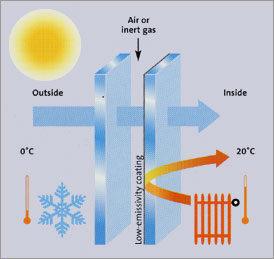
Double glazing, which adds another pane of glass, with a sealed gap between the two panes, is a much more expensive solution. Double glazing can halve the heat loss through the glass. Part of the benefit arises because the inner pane has still air beside it, which removes heat more slowly than the outer pane which is subject to wind chill. Adding a third pane (which is done in Scandinavia) reduces the heat loss still further. Some additional insulation can also be provided by filling the gap between the panes with an inert gas, typically argon. A suitable coating on the outside of the inner pane also improves insulation. An example is Pilkington K Glass™. The coating reduces the emission of heat from the house by reflecting it back into the house. Such a coating in double glazing can achieve the same level of insulation as triple glazing. Window frames are also important to consider. The heat conducted by the frame depends on its width, depth, and the material used. Softwood is the best insulator, followed by hardwood and then PVC. All these provide reasonable insulation. A metal such as aluminium (or formerly galvanised steel) is sometimes used, as this provides durability and a narrower frame. However, metals are very good conductors of heat, and if a metal frame is to be fitted it is important that it incorporates an insulating layer to limit heat loss. Secondary glazing is a less expensive alternative to fitting double glazing on an existing property. It is often the only option for listed buildings where the appearance must be preserved. In this case a second window is installed inside the existing window. The energy benefit can be similar to fitting double glazing. One supplier is Protech Limited. Limiting heat gain is the other side of the window story. Large windows facing the sun on a summer day can overheat the room. Heat gain can be reduced by reflecting the sunlight using light coloured curtains or blinds, or by the use of shutters. It can also be reduced by a suitable coating. A very thin film of gold is sometimes used on office windows. Refrigerators, freezers and fridge-freezers 
These are typically the most energy-intensive appliances in the home. Recent models are much more efficient than the ones that were available even a few years ago, but there are still big differences. Look for models rated A++. The difference in energy consumption between fridge-freezer models could be worth up to £50 a year. Energy costs of freezers and refrigerators can also be reduced by waiting for hot food to cool before placing it in the freezer, by checking freezer seals regularly, and by keeping the freezer defrosted (if it is not a self-defrosting model) since a thick layer of ice reduces efficiency. Refrigeration generates heat, and it is very important to have sufficient ventilation, especially to the coils behind the fridge or freezer. If they are closed in, too close to a wall, or even covered in dust and cobwebs, the air cannot circulate and the fridge or freezer has to work much harder to keep its contents cold. This can waste a very large amount of energy. Keeping a fridge or freezer in a very warm room or very close to a cooker also wastes energy, and if the temperature goes much above 30°C it will not work properly. Freezers are often put into places such as garages, but many models do not work in very cold conditions, below 5–10°C. Be sure to consult the manufacturer's specifications regarding the allowed range of ambient temperatures. 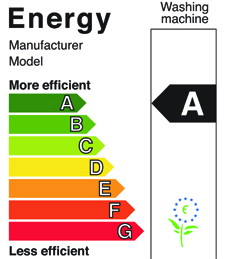
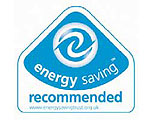
Choose low-energy appliances when replacing appliances. Look for the energy-saving recommended logo when buying new electrical appliances, and compare energy consumption ratings on the labels (see below). Do not run washing machines and dishwashers until there is a full load. Use low-temperature programmes in washing machines (30°C) and dishwashers (50°C, or lower if available). Dry clothes outdoors instead of using a drier whenever the weather permits. These are now mandatory in the EU for a range of household appliances, and also for cars. For most items they range from A to G, as shown. Refrigerators, freezers and fridge/freezers: Upright units now on sale no longer go below A, except for chest freezers which can go down to C. Therefore, the labels now include ratings up to A++. The ratings depend on both the energy consumed and the size of the fridge and/or freezer compartments. The labels also show the size of the compartments in litres, the projected annual consumption in kilowatt-hours, and the noise level in dB(A). Washing machines, tumble dryers and washer/dryers: The rating for washing machines is based on kilowatt-hours of electricity consumed per kilogram of load, using a 60°C cotton cycle with a maximum declared load of typically 6 kg. Therefore, the rating does not take account of the efficiency of lower-temperature cycles or ‘economy’ modes. This serious omission is about to be at least partly rectified, with ratings changing to be based on an average of 60°C and 40°C cycles. For tumble dryers the scale is for a cotton drying cycle and is based on kilowatt-hours per kilogram. Different scales apply for condenser and vented dryers. Most tumble dryers are rated C, with only a few rated A or B. The labels also have information on total energy consumption per cycle in kilowatt-hours, maximum spin speed, total cotton capacity in kilograms, water consumption per cycle in litres, and noise level in dB(A). Dishwashers: The rating takes account of the number of place settings (most commonly 12), and depends on the total kilowatt-hours consumed per 12 place settings. Very few dishwashers are now rated below A, so new A+, A++ and A+++ ratings are being introduced. The label also includes the total energy consumption per cycle in kilowatt-hours, the efficiency of the washing cycle and drying cycle separately, the capacity in place settings, the water consumption in litres per cycle, and noise level in dB(A). The ratings do not take account of the efficiency of lower-temperature or ‘economy’ modes, which is a serious omission. Ovens: In addition to the overall rating, the label also contains the energy consumption in kilowatt-hours, the volume in litres, and the size (small/medium/large). Air conditioners: Only applies to units under 12 kilowatts. In addition to the overall rating, the label also contains the projected annual energy consumption (assuming full load for 500 hours per year), the cooling output at full load in kilowatts, the energy efficiency ratio in cooling mode at full load, the cooling mode (air or water cooled), and the noise rating in dB(A). Light bulbs: In addition to the overall rating, the label also contains the light output of the bulb in lumens – this allows you to compare light output of bulbs of similar wattage, the electricity consumption in watts, and the average lifetime in hours. Low-energy bulbs are rated A or B, most halogen bulbs are rated D, and incandescent bulbs are usually E or F. Cars: Here the rating is based not on electricity consumption but on carbon dioxide emissions, in grams per kilometre travelled. The ratings are A (less than 100 g/km), B (up to 120 g/km), C (up to 140 g/km), D (up to 160 g/km), E (up to 200 g/km), F (up to 250 g/km) and G (over 250 g/km). The label also shows the fuel used, the transmission type, the weight, the fuel consumption for urban, extra-urban and combined test cycles, and the carbon dioxide emission in grams per kilometre. Although similar, note that these are not the same as the bands for annual road tax, which are given on our car choice page. Most homes now have a wide variety of electronic devices and gadgets that each consume small amounts of electricity when they are on ‘standby’, and often when they are switched off. These small amounts add up because there are probably more of them than you realise, and they are on all the time. There is more information, indicating which items are most likely to be the most costly, here. 
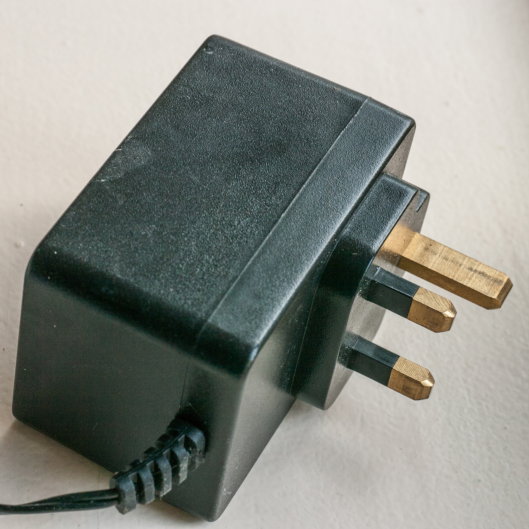
Switch off TVs, set-top boxes, and video recorders at the socket (not just on the box) whenever possible. Switch off computers, screens, printers and all other connected devices at the socket when not being used for any length of time. For short periods put the computer to sleep. Disconnect any devices that are not being used regularly, or turn them off at the socket. External power supplies should be switched off at the socket or unplugged. (These are the ‘bricks’ built into mains plugs, or the small boxes in the mains lead – photo at left of one example). They are a frequent cause of wasted electricity. Chargers should be switched off at the socket or unplugged when device is fully charged or they are not in use. The main options that might be considered for domestic energy generation with less use of fossil fuels are: 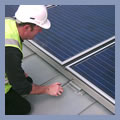
These are discussed on our domestic energy generation page – it describes what is involved for each of these and their pros and cons. Financial help: Grants for installing insulation, the Feed-in Tariff for generating electricity, the Renewable Heating Incentive and loans from the Green Deal are all discussed on our domestic grants page. |
 |
If you have any comments or queries about this website please contact the
webmaster. |
© Blewbury Energy Initiative 2014 |